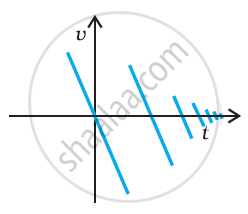Advertisements
Advertisements
प्रश्न
In Exercise, we have carefully distinguished between average speed and magnitude of average velocity. No such distinction is necessary when we consider instantaneous speed and magnitude of velocity. The instantaneous speed is always equal to the magnitude of instantaneous velocity. Why?
उत्तर १
Instantaneous velocity is given by the first derivative of distance with respect to time i.e.,
`v_"In" = (dx)/(dt)`
Here, the time interval dt is so small that it is assumed that the particle does not change its direction of motion. As a result, both the total path length and magnitude of displacement become equal is this interval of time.
Therefore, instantaneous speed is always equal to instantaneous velocity.
उत्तर २
Instantaneous velocity is the velocity of a particle at a particular instant in time. In this case of a small interval of time, the magnitude of the displacement is effectively equal to the distance travelled by the particle in the same interval of time. Therefore, there is no distinction between instantaneous velocity and speed.
APPEARS IN
संबंधित प्रश्न
A woman starts from her home at 9.00 am, walks with a speed of 5 km h–1 on a straight road up to her office 2.5 km away, stays at the office up to 5.00 pm, and returns home by an auto with a speed of 25 km h–1. Choose suitable scales and plot the x-t graph of her motion.
A jet airplane travelling at the speed of 500 km h–1 ejects its products of combustion at the speed of 1500 km h–1 relative to the jet plane. What is the speed of the latter with respect to an observer on ground?
Read the statement below carefully and state, with reason and example, if it is true or false:
A particle in one-dimensional motion with zero speed may have non-zero velocity.
A man walks on a straight road from his home to a market 2.5 km away with a speed of 5 km h –1. Finding the market closed, he instantly turns and walks back home with a speed of 7.5 km h–1.
- What is the magnitude of average velocity, and
- average speed of the man over the interval of time
- 0 to 30 min,
- 0 to 50 min,
- 0 to 40 min?
[Note: You will appreciate from this exercise why it is better to define average speed as total path length divided by time, and not as magnitude of average velocity. You would not like to tell the tired man on his return home that his average speed was zero!]
Suggest a suitable physical situation for the following graph:

In the following figure shows the graph of the x-coordinate of a particle going along the X-axis as a function of time. Find instantaneous velocity at 2, 5, 9 and 12s.

Write the SI units of speed and average speed.
In one dimensional motion, instantaneous speed v satisfies 0 ≤ v < v0.
A particle executes the motion described by x(t) = x0 (1 − e − γt); t ≥ 0, x0 > 0. Where does the particle start and with what velocity?
A particle executes the motion described by x(t) = x0(1 − e −γt); t ≥ 0, x0 > 0. Find maximum and minimum values of x(t), v(t), a(t). Show that x(t) and a(t) increase with time and v(t) decreases with time.
